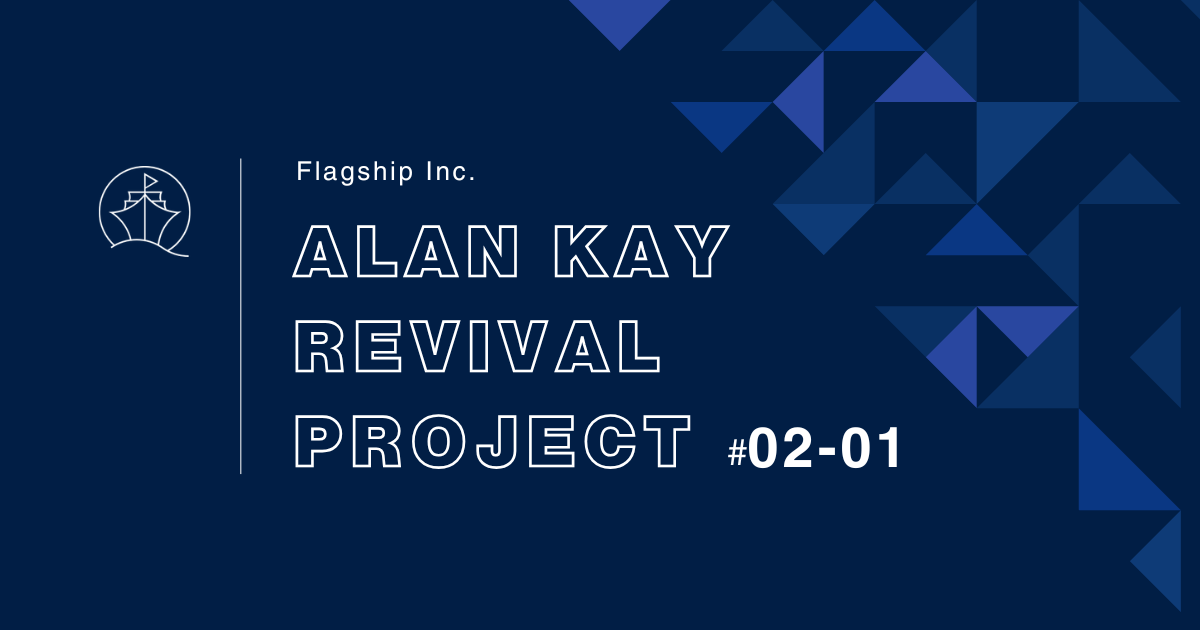Alan Kay Revival Project, 2nd Report (1/4)

On September 4, 2024, we held the second Alan Kay Study Group meeting. For this session, our study material was not a book or paper, but rather Alan Kay's keynote speech given in Japan in 2018.
In our first study group meeting, we learned through Alan Kay's career history that he wasn't just a computer scientist - he was well-versed in many academic fields, which became the driving force behind his innovative ideas and ability to pioneer the future. In this second meeting, we explored the achievements of Engelbart, who greatly influenced the background of Alan Kay's impact on modern computers. We'd like to discuss with everyone how much of Alan Kay's Dynabook concept has been realized.

Marcin Wichary from San Francisco, U.S.A. - Alan Kay and the prototype of Dynabook, pt. 5, CC Attribution 2.0, via Link
The keynote speech we studied was part of the "Internet Commercialization 25th Anniversary & 'The Demo' 50th Anniversary Symposium 'IT25-50 ~To Those Who Really Want to Change the World~'" held at Keio University's Mita Campus on December 10, 2018. The lecture was released with Japanese subtitles, and a full Japanese transcript is available. Also, the event's special webpage contains extensive information about this symposium, so please check it out.
While the lecture is about 40 minutes long, its content is very dense, and with all the information included in the slides, it could take 2-3 hours to present thoroughly. Therefore, we decided to publish the study group report in four parts. Part 1 features background commentary on the lecture by Mr. Hiwatashi, representative of NPO Talking, which hosts this study group.
Event page: What is IT25-50?
Past Alan Kay Revival Project Related Articles
| Published 2024/8/26 | Launch of Alan Kay Revival Project |
| Published 2024/8/26 | Alan Kay Revival Project First Report |
IT25-50 Symposium Alan Kay Keynote (Commentary by Mr. Hiwatashi)
ITday Japan. (2019, May 22). IT25-50 Symposium Alan Kay Keynote (with Japanese subtitles) IT2550_Alan Kay_Keynote[Video]. YouTube.https://youtu.be/-EdLBpFjKL8
This Alan Kay lecture was given to commemorate the 50th anniversary of Douglas Engelbart's historic "Big Demo" and the 25th anniversary of internet commercialization. It explains Engelbart's great role in computer history and introduces his achievements, which are rarely discussed in Japan. While the video is easy to watch, the discussion itself is extremely advanced. Alan Kay's lecture interweaves his spoken words, slide images, and slide commentary to develop a dense discussion. I'll explain the key points of the video to deepen understanding.
1968 as an Epoch-Making Year (0:00~)
1968 was an extremely important year in computer development history. Engelbart's legendary "Big Demo" was held at Stanford University, the world's first pen-based system GRAIL and VR technology were announced, and Alan Kay's tablet-type educational PC "Dynabook" idea emerged among other significant events.
While Engelbart's demo is very famous among those involved with computers, few people deeply understand the ideas Engelbart had in mind. Kay quotes a conversation with Bret Victor, ironically noting that while people talked about Engelbart's technologies like the mouse and display, they showed no interest in his truly revolutionary ideas.
Engelbart's Innovation (11:28~)

SRI International - SRI International, CC Attribution-ShareAlike 3.0, via Link
Many of the technologies thought to have first appeared in Engelbart's demo were actually introduced before 1968. In 1951, MIT unveiled Whirlwind, the world's first interactive computer, and its technology evolved into the SAGE air defense system in 1956. In 1962, Sketchpad introduced ideas that would become fundamental to modern computers: objects, simulation, icons, windows, clicking, and zooming. The first personal computer LINC was developed, and in 1963, the tablet computer The RAND Tablet was announced.
As we can see from this, the essence of Engelbart's achievement wasn't in the newness of the technology. According to Alan Kay, Engelbart's greatness lies in his idea of integrating these technologies, which was described in his 1962 paper "AUGMENTING HUMAN INTELLECT: A CONCEPTUAL FRAMEWORK".
What Engelbart Envisioned (14:28~)
In the 1940s, Engelbart worked as a Navy radar technician, where he encountered cathode-ray tubes. The CRT displayed not just signals, but also symbols like letters and numbers, and situations showing the overall context. He realized that machines could display information through the combination of these three elements. He was also greatly influenced by Vannevar Bush's 1945 paper introducing the idea of MEMEX (Memory Expander). In 1950, he joined a project to develop early digital computers from scratch, learning not just how computers work, but how to build them and how to program and operate them.
In the midst of the Cold War, feeling anxious about the world's future, Engelbart began working on computer development as a new tool to solve humanity's problems, following Einstein's words that "We cannot solve our problems with the same thinking we used when we created them."
To be continued in Part 2!
